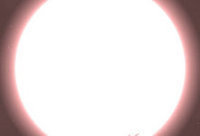New mysteries of red supergiant Betelgeuse
Astrophysicists, watching red supergiant Betelgeuse found a number of dust arcs around the star. Most likely, the arcs are the traces of material discarded at different stages of the evolution of the star. In addition, there was an elongated object discovered, whose nature remains unclear. However, it is clear that the object may collide with the star in 12 million years.

The star of Betelgeuse in constellation Orion can not be called a small and an inconspicuous one. This red giant, which is at a distance of 495 to 640 light years from our solar system, has a mass of 17 solar masses. Its diameter is larger than that of our sun by about 950-1000 times. The brightness of the star is very powerful too - it is 80-105 thousand times stronger than of our Sun by. In addition, Betelgeuse is one of the largest stars known to astronomers: if it were the sun of the solar system, it would fill the orbits of Mars and even Jupiter.
However, even such a giant that flies through the universe at a speed of about 30 kilometers per second, has its little secrets. For example, it is still unknown at what stage of evolution the star remains. It is traditionally believed that Betelgeuse, which is about 10 million years old, is already in the phase of carbon burning. Therefore, the star undergoes through a supernova explosion within one or two thousand years. According to scientists, they can observe it from the variable brightness of the celestial body.
One may assume that the star entered the red giant phase a long time ago - at least several thousands of years ago. However, a different point of view on the evolution of the star appeared during the 1980s. Surprisingly, it was expressed by archaeologists, rather than astrophysics. During excavations in the north of China, specialists from China discovered reports made by ancient astronomers, dated from the first century BC. It is clear from those records that the color of Betelgeuse was white or yellow at that time (in ancient Chinese language, these two colors were often marked by one and the same hieroglyph).
There was also a message from Ptolemy, dated back from the second century AD, in which he described Betelgeuse as a red star. It turns out that the transformation of the star, during which the yellow dwarf discarded its shell of gas and dust and became a red giant, took place about two thousand years ago! All this made Chinese astronomer Fang Li Zhi suggest that Betelgeuse actually just entered the red giant stage and that the supernova explosion would occur in no less than 3-5 thousand years.
Another mystery of Betelgeuse is the existence of the gas-dust nebula around the star. Scientists could not see the nebula for quite a while due to the bright light of the star. However, when the nebula was discovered, questions still remained. Is the nebula the remains of the shell, or does it have a different origin? Experts have recently managed to study some parts of the nebula in infrared spectrum.
What's going on around the red giant? Astrophysicists saw several dust arcs in the direction of the movement of the star. They are witnesses of the tumultuous history of the emission of material from the star. Interestingly, closer to the star, the interior of the ejected shell shows asymmetric structure. Large convection cells in the outer atmosphere of the star might have led to local "lumpy" dust emissions at different stages in the history of Betelgeuse.
It turns out that much of the nebula was formed from the material of the ejected shell and the substance that the star ejected later. Moreover, there is a linear formation behind the dust arcs of the star. Early hypotheses explained the existence of the stripe with the release of material at the previous stage of the stellar evolution. A new image analysis suggests that it was either something connected with the magnetic field of the galaxy, or the edge of an interstellar cloud, lit by the light emanating from Betelgeuse.
Thus, if we assume that the stripe is a separate celestial body, then, taking into account the movement of Betelgeuse and its arcs, as well as the distance between them and the stripe, one can predict that the arcs will collide with it in five thousand years. The red supergiant will crash into this mysterious formation about 12,500 years later.
Anton Evseyev
Pravda.Ru
Subscribe to Pravda.Ru Telegram channel, Facebook, RSS!


